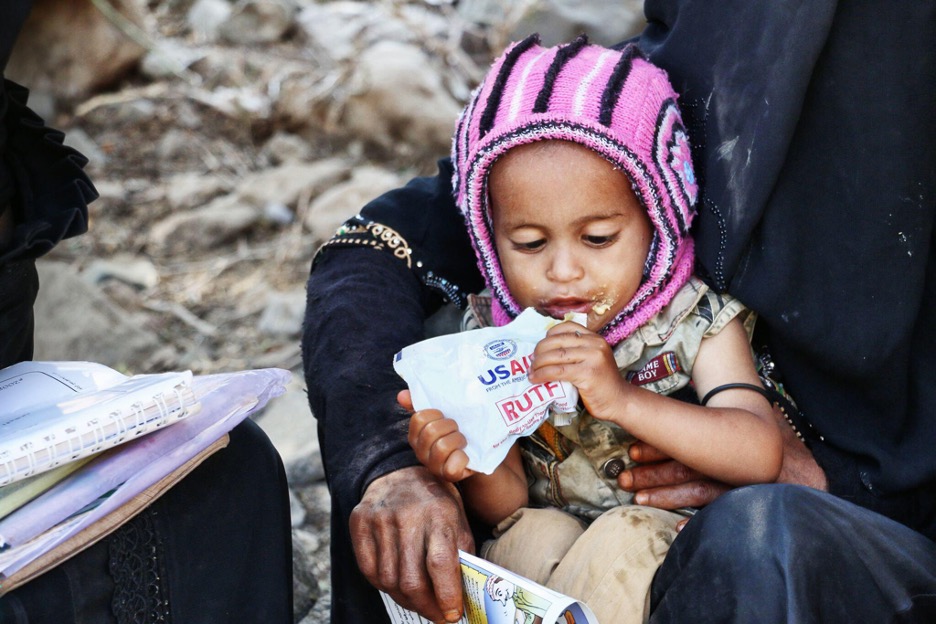Published: 09/15/2022
By Jamie Hansen, Communications Manager at the Stanford Center for Innovation in Global Health

Access to reliable and nutritious food is critical to good health and childhood development. Such access is increasingly threatened in many parts of the world by factors like climate change, political unrest, conflict, and COVID-19. These inter-related crises are driving food insecurity and malnutrition for more than 800 million people around the world. Some countries, like Somalia and the Tigray region of Ethiopia, now face the threat of famine.
Global Health Faculty Fellow Eran Bendavid, MD, MS, spends a lot of time thinking about how such complex and inter-related factors impact a population’s health. Bendavid began his training and career focused on infectious diseases and over time has expanded his research to explore how changing environments (natural, social, or political) impact and shape population health in poorer parts of the world.
We spoke with Bendavid about which populations are most vulnerable to malnutrition and food insecurity driven by poverty, climate change, and natural disasters — as well as the increasing role that conflicts and politics play in access to food.
What are the primary drivers of food insecurity around the world, and who is most at risk?
When I think of places that are food insecure, I think of two main drivers: poverty and food distribution.
Food distribution — ensuring that food is flowing and everyone across a country has access — is deeply tied to big famines. The issue with famines is typically not that there isn’t enough food in a country, but rather that a region for some reason has become isolated or cut off from food. Indian economist Amartya Sen has written that, throughout history, famines have primarily taken place because a government is not capable or motivated to provide for its people, or because conflict has isolated an area. He argues that famines do not happen under a caring and capable government. With all the terrible things happening in the world, there is still more than enough food to put in every mouth every night. What we see happening with the famine in Somalia is in some ways a case study of how conflict and political insecurity collide. Not only is the government busy with conflict and insurgencies, but NGOs are afraid to go to affected areas, and even those that are not afraid have a really hard time reaching them.
And while malfunctioning food distribution systems often drive extreme famines, the more common form of hunger, food insecurity (kids going to bed hungry or not having enough to grow and thrive) is more often related to poverty and cycles of hand-to-mouth existence. People living in these situations, like smallholder farmers, can be very susceptible to changes in climate or economics.
COVID-19 is the elephant in the room with food insecurity: The World Food Programme has estimated around two hundred million kids are going to be food-insecure as a result of the pandemic and the resulting reduction in global trade and increase in global poverty. It’s been a pretty dramatic setback to development. I think we’re going to see the impacts of that ripple across many sectors for a long time.

Credit: UNICEF
How is climate change affecting food insecurity?
This is a huge question and topic of research. For a lot of people, the fields behind their house are a primary source of food or income. For a smallholder family dependent on food they grow, drought, heatwaves, and floods can be devastating. This reflects a very large number of people across large portions of the world. These people and places are the most vulnerable to the impacts of climate change.
Some regions, including parts of Africa, Southeast Asia, and Central America, are already no longer amenable to agriculture as a result of climate change. You see a lot of immigration out of these areas when smallholder farmers’ traditional livelihoods are no longer sustainable. Many are forced to move to informal settlements on the outskirts of cities, and they come with nothing. It’s typically not beneficial for anybody – not the migrants, not the cities, and not the communities left behind.
For a lot of people, the fields behind their house are a primary source of food or income. For a smallholder family dependent on food they grow, drought, heatwaves, and floods can be devastating. This reflects a very large number of people across large portions of the world. These people and places are the most vulnerable to the impacts of climate change.
My group has just begun to study the health impacts of large natural disasters (specifically, cyclones and floods) whose intensity and frequency are increasing due to climate change. To date, research on health impacts of major climatic drivers in lower-income countries has been scant. Understanding the impacts of factors such as pollution and warming is important because while the impacts are clearly large, the magnitude matters for contextualizing and acting on what we are facing.
Historically, one of the key mechanisms by which hurricanes exact their very long-lasting impact is through physical destruction — including infrastructure, homes, and crops. We are looking at historic cyclone and flood events and track their impact on childhood outcomes. We want to know how these factors affect the mother’s pregnancy, the child’s ability to survive her vulnerable first few months of life, vaccination rates, and nutritional status.

Photo Credit: International Food Policy Research Institute / 2010 / Flickr
What are the health impacts of food insecurity and hunger, especially on more vulnerable populations like pregnant women and children?
Most commonly, we see poor childhood growth. Low height or weight for age — these are measures of malnutrition driven by a lack of access to macronutrients like carbohydrates, proteins, and fats.
Child growth also requires micronutrients. Vitamins, iron, and zinc matter for cognitive and immune functioning. When children lack access to micronutrients, you may see poor performance in school, anemia, or ineffective immune systems and resulting susceptibility, especially to some infectious diseases.
When immune systems suffer from malnutrition, you see children dying from diseases that don’t have to be deadly, like diarrheal illness and pneumonia. So while the past 50 years have brought along enormous improvement in many health indicators for children under five overall, illnesses related to malnutrition are still major drivers of the remaining morbidity and mortality in young children. Adequate macro- and micronutrient access (along with clean water) are extraordinarily important to combating these diseases.

Stuart Price, United Nations, Flickr
The World Food Programme describes conflict as the largest driver of hunger worldwide, with more than 60 percent of the world’s hungry people living in areas of war and conflict. How does conflict drive food insecurity and famine?
One scholar of international development calls conflict “development in reverse.” Destruction of roads and infrastructure, poorer distribution of food, fewer markets, increased isolation — these are the kinds of things that really make the food insecurity issue a lot worse.
Once there’s a conflict in an area, not only is it more vulnerable to future conflicts, it’s vulnerable to all kinds of things. Areas rife with conflict tend to lose international and humanitarian support. For instance, it’s going to take a long time before people are going to be confident that they can invest in places like Afghanistan because of concerns it will fall into conflict again. The issues we see in our studies of conflict areas, time and time again, are a greater number of kids with stunted growth in the years after the conflict begins, along with setbacks in food supplementation and vaccines. The effects can last for several years, even after the conflict ends.
What are the most successful or promising interventions for food insecurity?
There’s been a lot of really important progress on the extreme end of malnutrition, where it takes a special intervention to bring children back from the brink of death. Over the last few decades, an impressive set of operations have provided effective treatment for severe malnutrition. Thanks to these systems for delivering supplements, the outcomes for very young and very malnourished children have improved a lot.
We’ve also seen effective mass distribution of micronutrients — for instance, iodized salts and iron–fortified foods, both through fortifying processed foods and growing crops modified for higher nutritional value. These programs have been very effective at reducing conditions associated with micronutrient deficiencies.
A new problem, ironically, is rising obesity rates. As countries develop, they transition to the population being more overweight than underweight. At the same time, children may still be malnourished in terms of the nutrients they are receiving from the food. Many people are trying to figure out how to address the “double burden” of being both overweight and undernourished. This is one of the coming challenges in the sphere of food security and health.